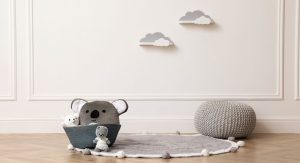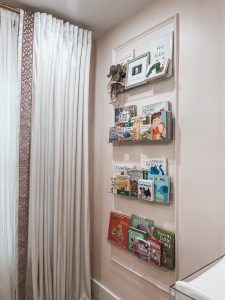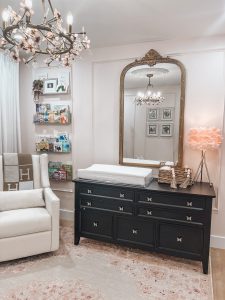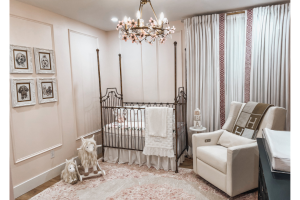 Designing a child-friendly interior is all about creating a visually appealing environment and providing a safe, functional, and inspiring space for children to thrive and grow. A well-designed interior for children should cater to their needs, stimulate their creativity, and encourage their learning and development. From living rooms to bedrooms, designing spaces for children requires careful consideration of various factors, such as safety, durability, comfort, and accessibility. From a mom’s and interior designer’s insight, design plays a crucial role in shaping children’s physical and emotional environment. You can easily create a safe and stylish home for your little ones with a few design tips and tricks.
Designing a child-friendly interior is all about creating a visually appealing environment and providing a safe, functional, and inspiring space for children to thrive and grow. A well-designed interior for children should cater to their needs, stimulate their creativity, and encourage their learning and development. From living rooms to bedrooms, designing spaces for children requires careful consideration of various factors, such as safety, durability, comfort, and accessibility. From a mom’s and interior designer’s insight, design plays a crucial role in shaping children’s physical and emotional environment. You can easily create a safe and stylish home for your little ones with a few design tips and tricks.
1. Focus on Safety
First and foremost, safety should be a top priority. Ensure that any furniture or decor items are securely anchored, and avoid sharp edges or anything that could pose a choking hazard. Using non-toxic materials and finishes whenever possible is also a good idea. When choosing decor for your home, make sure to select child-safe options. Avoid items with sharp edges or breakable materials. Instead, opt for soft, rounded decor and safer swaps like acrylic instead of glass. Utilizing wood and woven pieces that can double as toys and decor has been a game changer in my home.
 2. Choose Durable and Easy-to-Clean Materials
2. Choose Durable and Easy-to-Clean Materials
An important consideration is durability. Kids are notoriously hard on furniture and fabrics, so opt for materials that can withstand the wear and tear of daily life. Stain-resistant fabrics like leather, microfiber, or performance fabrics for your sofas and chairs are proven durable. Slip-covered pieces are a favorite for the living room and dining area; they can easily be removed and tossed in the washer for a quick refresh or inexpensively replaced.
3. Incorporate Soft Surfaces
Children love to play on the floor, so it’s essential to incorporate soft surfaces like area rugs or foam mats. Not only will this provide a comfortable place for your children to play, but it will also help prevent injuries from falls. Floor cushions are also great for older children, as they can be easily relocated and are not a falling hazard like some furniture tends to be. This is also a great way to incorporate an accent color or pattern.

4. Create a Kid-Friendly Zone
Designate a specific area of your home as a kid-friendly zone, such as a playroom or a corner of the living room. This will give your children a space to play and be creative without taking over the entire house. Rotating toys keeps the number of toys to a minimum, and research shows this allows children to be more creative during playtime. I change out my daughter’s basket of toys weekly to keep the mess down and energize her imagination without being overstimulated.

5. Use Storage to Keep Clutter at Bay
Children come with much stuff, so having plenty of storage space to keep clutter at bay is essential. Baskets are my best friend and are used in every room in my home. Use baskets, bins, and shelves to organize toys, books, and other items. This will keep your home neat and make it easier for your children to find what they want. Don’t forget vertical storage; this works exceptionally well for books and collections.
6. Choose Toys to Complement Existing Decor
Inevitably, your most-used toys will likely live in shared areas like the living room. To help tone down visual clutter, opt for toys that are cohesive with your existing interior style. For instance, select a neutral wood-tone baby gym vs. a bright, colorful one. This will help tone down multiple loud items and be just as fun. This works exceptionally well in small areas where physical and visual clutter can overwhelm.
7. Incorporate Fun and Playful Elements
Incorporate fun and playful elements into your home design. Hang a swing in your child’s bedroom, create a chalkboard wall in the playroom or kitchen, or add a slide to your backyard. Murals are a great option to incorporate a fun design that is large in scale without breaking the bank. These elements will not only make your home more fun for your children, but they will also create lasting memories for your family.
8. Color and Patterns
When it comes to color and pattern, don’t be afraid to have a little fun! Bright colors and bold prints can add personality and playfulness to a room and help create a welcoming space for kids. Just be sure to balance out the playful elements with some more neutral pieces to avoid overwhelm. You can also use toys and books to help bring in color if you prefer a neutral setting.

9. Where to Shop?
I love utilizing Facebook Marketplace as a starting point. You can generally find new items to project pieces and everything in between. Amazon, Pottery Barn Kids, and HomeGoods are on my list for nurseries/children’s rooms. Designer tip: avoid going “matchy-matchy.” Mixing different materials and elements helps create a more lived-in and professionally sourced space. Plus, this makes things easier if you’re going the pre-loved route.
10. Grow with your Child
Finally, think about how your space can grow with your child. While it’s tempting to design a nursery or playroom specifically for a young child’s needs, it’s essential to consider how the space will function as your child grows older. Invest in pieces that can be easily updated or repurposed, and avoid anything that feels too babyish or overly themed. For instance, instead of a changing table, consider adding a changing topper to a dresser which can easily be removed when you’re no longer in that season.

Designing a home with kids in mind can be challenging, but creating a functional and beautiful space is also a fun opportunity. With some planning and foresight, you can create a space that works for everyone in your family! As a mom, you want your home to be a safe and comfortable place for your children to grow and play, without sacrificing style for functionality. I hope these tips help you do just that!












